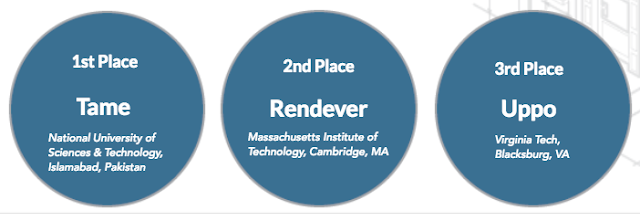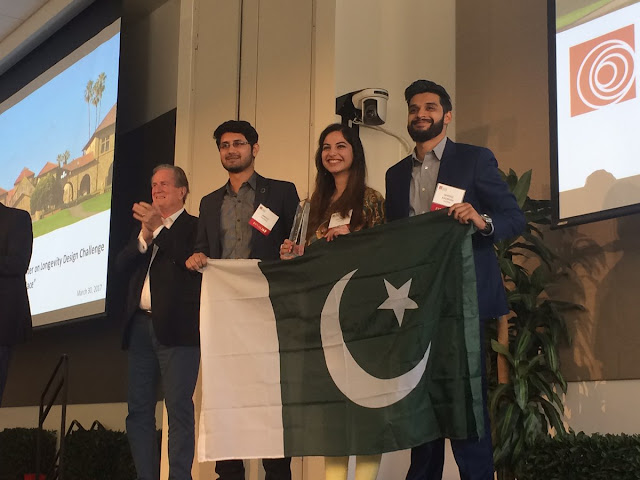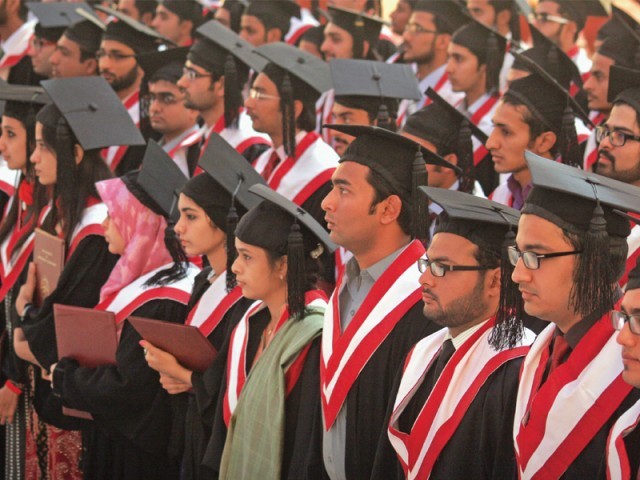PakAlumni Worldwide: The Global Social Network
The Global Social Network
Pakistani Students Team Wins First Place in Stanford Design Contest
A 3-person team of Pakistani students, including a female student from Islamabad's National University of Science and Technology (NUST), won first place in a contest organized by Stanford Center of Longevity. The team's entry is a device they designed and prototyped that enables tremor patients to perform daily routine tasks.
The Purpose:
The purpose of the contest is to encourage innovation to help improve the quality of life of aging populations in the West and the rest of the world.
The 2017 Stanford Longevity Design Challenge had the following goals:
1. Create well-designed, practical solutions that address key issues associated with aging
2. Encourage a new generation of students to become knowledgeable about aging issues
3. Provide promising designers with a path to drive change in the world
The Winners:
NUST's Hooriya Anam, Awais Shafique, and Arsalan Javed defeated teams from around the world with their anti-tremor prototype project TAME. The team from famed Massachusetts Institute of Technology (MIT) placed second while Virginia Tech team stood third, according to results announced by the Center.
NUST's Stanford Challenge Winners From L to R: Arsalan Javed, Hooriya Anam, Awais Shafique |
The Competitors:
In addition to NUST, MIT and Virginia Tech teams, there were other teams from Cornell University, University of Sao Paolo Brazil, China's Beijing University and Silicon Valley's Stanford University who also competed in the contest.
The winners received $17,000 in cash prizes along with paid travel to Stanford where they presented their designs to industry, academic, and government leaders.
College and University Enrollment in Pakistan:
Wins such as the Stanford Challenge are the result of improvements in higher education in Pakistan since the year 2000.
There are over 3 million students enrolled in grades 13 through 16 in Pakistan's 1,086 degree colleges and 161 universities, according to Pakistan Higher Education Commission report for 2013-14. The 3 million enrollment is 15% of the 20 million Pakistanis in the eligible age group of 18-24 years. In addition, there are over 255,000 Pakistanis enrolled in vocational training schools, according to Technical Education and Vocational Training Authority (TEVTA).
Graduation Day at NED Engineering University For 1300 Graduates in 2013 |
Pakistani universities have been producing over half a million graduates, including over 10,000 IT graduates, every year since 2010, according to HEC data. The number of university graduates in Pakistan increased from 380,773 in 2005-6 to 493,993 in 2008-09. This figure is growing with rising enrollment and contributing to Pakistan's growing human capital.
Higher education in Pakistan has come a long way since its independence in 1947 when there was only one university, the University of Punjab. By 1997, the number of universities had risen to 35, of which 3 were federally administered and 22 were under the provincial governments, with a combined enrollment of 71,819 students. A big spending boost by President Pervez Musharraf helped establish 51 new universities and awarding institutions during 2002-2008. This helped triple university enrollment from 135,000 in 2003 to about 400,000 in 2008, according to Dr. Ata ur Rehman who led the charge for expanding higher education during Musharraf years. There are 161 universities with 1.5 million students enrolled in Pakistan as of 2014.
R&D Investment:
Rise of research and publications at Pakistani universities began during Musharraf years when the annual budget for higher education increased from only Rs 500 million in 2000 to Rs 28 billion in 2008, to lay the foundations of the development of a strong knowledge economy, according to former education minister Dr. Ata ur Rehman. Student enrollment in universities increased from 270,000 to 900,000 and the number of universities and degree awarding institutions increased from 57 in 2000 to 137 by 2008. Government R&D spending jumped seven-fold as percentage of GDP from 0.1% of GDP in 1999 to 0.7% of GDP in 2007. It has since declined as percentage of GDP.
Summary:
Pakistani students, scientists and researchers are continuing to produced highly recognized and cited research in spite of serious economic and security challenges. Enrollment in higher education is rising and giving a boost to innovation. With better policy focus and more investment in higher education, Pakistan can make an even greater impact with its young demographics.
Related Links:
Pakistan Beats BRICS in Highly Cited Research
Rising College Enrollment in Pakistan
10 Pakistani Universities Among Asia's Top 300
Genomics and Biotech Research in Pakistan
Human Capital Growth in Pakistan
Educational Attainment in Pakistan
-
Comment by Riaz Haq on January 31, 2022 at 5:00pm
-
Pakistani start-up wins first place across South Asia in maiden Stanford SEED Spark Program
https://southasia.stanford.edu/news/pakistani-start-wins-first-plac...
January 21, 2022
By
Usman Aslam, TechJuice
National Incubation Center (NIC) Lahore at LUMS nominated start-up Codeschool.pk has won top laurels and a cash prize in the capstone business pitch competition in the Stanford Seed Spark Program for high-achieving entrepreneurs across South Asia. This was the inaugural cohort from Pakistan and was introduced by NIC LUMS.
“Our partnership with Stanford SEED Spark reflects our confidence in Pakistani entrepreneurs and their ability to compete with the very best talent globally,” said Saleem Ahmad, Chairman NIC LUMS Lahore, and Quetta at the graduation ceremony of Stanford SEED Spark’s inaugural cohort in Pakistan. “Our conviction is reinforced by the fact that all of NIC LUMS mentored start-ups made the top 20 finalists and have brought home much pride in also winning the top position across South Asia.”
83 ventures participated in the program, from across 17 collaborating institutions such as IIT Bombay, TiE Chennai and CII-Young Indians. The competition selected only the top 20 graduates as finalists. After a rigorous scoring process, the top three start-ups were selected to win a cash prize as well as a virtual showcase feature in the global Stanford SEED Spark gallery.
“Our collaboration with NIC LUMS for Spark’s maiden cohort in the Pakistan start-up ecosystem has been a great experience,” said P. R. Ganapathy, Regional Director, Stanford Seed South Asia. “We are thrilled to see the energy and enthusiasm that NIC LUMS nominated entrepreneurs brought to the program. We are looking forward to meeting more innovators and problem solvers from Pakistan to apply and make best use of a word-class online entrepreneurship program at their own pace and time.”
Speaking about her journey with the program, co-founder Sadaf Rehman commented,
“The Stanford SEED Spark Program was instrumental in helping us articulate our vision. The frameworks, expert sessions, as well as the one-on-one mentorship provided just the right mix to propel us beyond what we could have achieved on our own. I am deeply grateful to NIC LUMS for introducing this program to Pakistan, and for the networking opportunities and support that they have provided along our journey.”
Her venture, Codeschool.pk, provides fun, interactive coding classes to children aged six years and up, with the aim to promote critical 21st-century skills like problem-solving, creativity, and resilience. Within the first year of operations, the startup is reaching over 450 students in ten countries. She was mentored by LUMS alumnus Adeel Saya, Program Manager, Google in Zurich.
Another NIC LUMS-backed entrepreneur, Malik Waleed Tariq, founder of XStak, also made the top 20 finalist list. His venture is an all-in-one, self-service Retail Operating System that enables retailers to perform omnichannel commerce, marketing, payments, and business intelligence operations on a transaction-based pricing model. He was mentored by another LUMS alumnus, Ali Almakky, Strategy and Operations, JPMorgan, London.
Haris Anwaar, AWS Finance, Amazon, (Seattle) also joined the NIC mentors list with a start-up in the top 20 finalists.
The Stanford SEED Spark Program is a four-month training for early-stage entrepreneurs in the traction or growth stage and seeks to empower them with practical tools to refine and develop their businesses through an action-based curriculum, networking opportunities with peers, one-on-one mentorship, and live expert sessions. NIC LUMS brought the Stanford SEED Spark program to Pakistan and will be expanding it nationwide, with the second cohort due to begin in March 2022.
Comment
- ‹ Previous
- 1
- 2
- Next ›
Twitter Feed
Live Traffic Feed
Sponsored Links
South Asia Investor Review
Investor Information Blog
Haq's Musings
Riaz Haq's Current Affairs Blog
Please Bookmark This Page!
Blog Posts
IMF Questions Modi's GDP Data: Is India's Economy Half the Size of the Official Claim?
The Indian government reported faster-than-expected GDP growth of 8.2% for the September quarter. It came as a surprise to many economists who were expecting a slowdown based on the recent high-frequency indicators such as consumer goods sales and durable goods production, as well as two-wheeler sales. At the same time, The International Monetary Fund expressed doubts about the Indian government's GDP data. …
ContinuePosted by Riaz Haq on November 30, 2025 at 11:30am
Retail Investor Growth Driving Pakistan's Bull Market
Pakistan's benchmark index KSE-100 has soared nearly 40% so far in 2025, becoming Asia's best performing market, thanks largely to phenomenal growth of retail investors. About 36,000 new trading accounts in the South Asian country were opened in the September quarter, compared to 23,600 new registrations just three months ago, according to Topline Securities, a brokerage house in Pakistan. Broad and deep participation in capital markets is essential for economic growth and wealth…
ContinuePosted by Riaz Haq on November 24, 2025 at 2:05pm
© 2025 Created by Riaz Haq.
Powered by
![]()




You need to be a member of PakAlumni Worldwide: The Global Social Network to add comments!
Join PakAlumni Worldwide: The Global Social Network